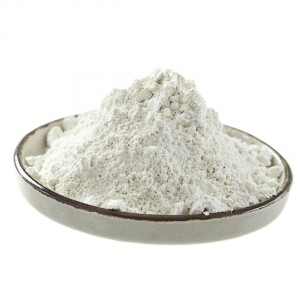Bentonite clay for intestinal problems

Many websites make claims about the ability of bentonite (montmorillonite) and other clays to detoxify harmful bacteria, viruses, parasites, etc. from the intestines.
For example, here’s a statement that I’ve seen over and over again on literally dozen of websites:
According to the Canadian Journal of Microbiology, bentonite can absorb pathogenic viruses, the mold aflatoxin, and pesticides and herbicides such as paraquat and Roundup.
Now here’s the thing: I know from my own experience, discussions I have had with doctors and NDs, and the experiences of my own readers that this statement is true. BUT I still like to see the data. Especially when you cite a scientific source.
However, the only reference I could find for this statement (cited on numerous websites) was: Canadian Journal of Microbiology, 1985, 31: 50-53
Looks legit, doesn’t it? Who would question such a reference? Well … .. after searching this publication, I believe that the article all of these websites are referring to is this (it is the only article in this issue that is content-related at all):
Specificity of virus adsorption on clay minerals, Steven M. Lipson, G. Stotzky, Canadian Journal of Microbiology, 1985, 31 (1): 50-53, 10.1139 / m85-011
But guess what? This paper does NOT really support this statement! I don’t want to bore you with the whole thing, but this very first sentence gives you an indication that this paper is not making the claims made in the statement quoted on so many websites: “Competitive adsorption studies showed that reovirus type 3 and Coliphage “T1 had no common adsorption sites on kaolinite and montmorillonite” …
So of course I had to look for legitimate scientific research to prove that bentonite clay actually helps the intestines detox by moving pathogenic bacteria, viruses, molds, parasites, etc., through your body through your feces (poo).
Because I had a fantastic stool softener and filler called MetaCleanse in my LTYG Shoppe that contained bentonite clay (along with psyllium and flaxseed – just a great combination) and I want my readers to know that I am telling them the truth about it. We also only sell pure bentonite earth – and I used it myself in large quantities for a two-week cleaning and detoxification process. Followed by lots of probiotics, of course! Since the manufacturer has stopped production of MetaCleanse, you can use 1 tbsp instead. sprouted flax and chia powder (available locally and online on different sites; you may need to purchase the two powders separately) along with 1/2 tsp. Bentonite clay.
Intestinal broom
The point about bentonite and other clays used as “intestinal brooms” is that they don’t just transfer the bad bacteria. Clay cannot distinguish between types of microorganisms – it just absorbs everything and carries it out! So let’s also talk about the word “adsorb” – no, it is not a spelling mistake and has a different meaning than the word “absorb”.
The value of montmorillonite (the active ingredient in bentonite) lies in its ability to adsorb (not absorb) many times its own weight and volume in a liquid medium. It has a predominantly negative charge that can attract many types of positively charged particles. The structure of Bentonite Clay helps it attract and soak up toxins and contaminants on its outer wall and then draw them into the inner center of the clay where they are held in place and then excreted with your stool.
It is this spongy property of clay that makes it a good anti-diarrhea substance while detoxifying your body! However, since montmorillonite draws both good and bad bacteria from the gut, it’s a good thing for an unhealthy bacterial flora. But if you’re supplementing probiotics and trying to implant healthy bacterial flora, then you certainly don’t want to ingest large amounts of a substance that pulls all of these good bacteria out of your gut as well!
Bentonite for detoxification or to stop diarrhea
Therefore, I would only use large amounts (2 tablespoons or more) of pure bentonite clay for detoxification or to stop diarrhea for a short time and then resort to the high-dose probiotic food supplement myself, which combats the cause of your diarrhea. Every now and then for two weeks, high-dose bentonite clay ensures a good, but gentle detoxification – followed by oral probiotics and Jini’s Probiotic Retention Enema.
Your best option for relieving persistent diarrhea or constipation can be to use a combination of psyllium, flaxseed, and bentonite clay. As long as you only use a small amount of bentonite per serving, it is safe for long-term use and of course you would not use it with your probiotics anyway.
A rule of thumb when using ANY detox or stool filler or “colon broom” is to take it off your probiotics for 2 hours – since you want your probiotics to nestle and stick to your gut wall, not be worn, or detox!
Bentonite combination for constipation
Here’s another important difference: if you’re only using bentonite clay on its own (1 tablespoon or more) it will absorb a lot of water, so it can be used to stop diarrhea or it can cause constipation in people with normal bowel function.
BUT, when used in smaller amounts and in combination with stool fillers / emollients like ground flaxseed, psyllium or chia, it relieves constipation as it makes your stool soft and spongy; stimulates peristalsis and makes it easier to pass. Hence, in both cases, avoiding hemorrhoids will help.
So for a strong detox you should use the bentonite alone for 2 weeks or less. But for persistent or intermittent diarrhea or constipation, or a gentler detox, combining bentonite with sprouted flax and chia seed powder would be a better option. Use 1/2 tsp. Bentonite on every 1 tbsp. Chia / flax. This will swell your stool and help absorb the excess water if you have diarrhea. If you suffer from constipation, it will keep your stool soft and spongy, stimulate peristalsis, and make it easier to pass. Hence, in both cases, avoiding hemorrhoids will help. Used at a low dose like this and taken at least 2 hours away from probiotics, bentonite can be used continuously.
Scientific data on bentonite
Anyway, now that you know more about how bentonite works, we come to the hard, scientific evidence I was talking about. It’s short but cute …
“Given the ubiquitous and widespread occurrence of clays in soils and sediments, it is not surprising that clays have long been used to combat toxins, albeit on a small scale or only locally. For example, “Lemnian earth,” known only for its location, was used medicinally in ancient Greece and Turkey to counteract the effects of snake bites and poisons and to heal festering wounds (Robertson, 1986). Likewise, Sudanese villagers for a long time along the Nile used a local clay – recently identified as bentonite – to purify the river’s murky waters. As a result, these people suffer less from gastrointestinal complaints than other nearby communities. Experiments showed that viruses (Lund and Nissen, 1986), parasites (Olsen, 1987) and many types of bacteria (Madsen and Schlundt, 1989) are removed from the water by the addition of the clay, probably as both an adsorbent and a flocculant for the disease-transmitting organisms. “(1)
So there you have it: viruses, parasites, bacteria, toxins – really great things, right? But wait, there’s more …
“Sound therapy is based on the Ability of clays and clay minerals to absorb and retain harmful and toxic substances. The beneficial effects of these materials on human health, particularly in the treatment of gastrointestinal diseases, have been recognized. Indeed, the eating of clay (‘geophagy’) has been practiced in all parts of the world since ancient times.
A study of the diets of certain tribes in the high Andes of South America and Central Africa, as well as the Australian Aborigines, showed that these people use clay to prevent stomach ache, dysentery, and food infections.
Although recent research has confirmed that clays and clay minerals have healing properties in general, the treatment of diseases continues to be the focus of attention. By adsorbing “aggressors” (infectious factors) of the gastrointestinal mucosal barrier, these materials can serve both as prophylactic and therapeutic agents. “(2)
In addition, clay can also be used externally (on the skin, in a bath, in an envelope, etc.) for various therapeutic purposes, but that’s another blog post!
ps I want to invite all the clay websites that are currently citing the wrong dates to come over here and copy / paste the correct material! And please check my sources again …
Footnotes:
1. Chapter 11.1 Clays and Clay Minerals For Pollution Control, GJ Churchman, WP Gates, BKG Theng, G Yuan, Handbook of Clay Science, 2006 Elsevier, edited by F. Bergaya, BKG Theng, G. Lagaly
2. Chapter 11.6 Clays And Clay Minerals As Drugs, MT Droy-Lefaix, F. Tateo, Handbook of Clay Science, 2006 Elsevier, edited by F. Bergaya, BKG Theng, G. Lagaly, page 743
References:
Robertson, RHS, 1986, Fuller’s Earth: A History of Calcium Montmorillonite. Volturna Press, Hythe, Kent.
Lund, E. and B. Nissen (1986). “Low-technology water purification using bentonite-clay flocculation, such as is done in Sudanese villages: Virological studies.” Water research 20: 37-43.
Olsen, A. (1987). “Low-technology water purification by bentonite clay and moringa oleifera seed flocculation as done in Sudanese villages: effects on Schistosoma mansoni Cercariae.” Water Research 21 (5): 517-522.
Madsen, M. & Schlundt, J. ‘Low Technology Water Purification by Bentonite Clay Flockulation as Performed in Sudanese Villages: Bakterial Examinations’ J. Water Research vol. 23, edition July 7, 1989.
Originally posted in September 2012. Last updated in August 2021.
![]()
Jini Patel Thompson is an internationally recognized expert in natural digestive disease healing. She healed herself from the widespread Crohn’s disease and has been drug and surgery free for over 20 years. Appeared on numerous podcast, television and radio shows in the US, UK, Canada and Australia, Jini gives people hope and visions on how to cure colitis, Crohn’s disease, diverticulitis and irritable bowel syndrome (IBS) in all natural methods. Her books on natural digestive disease cures have been sold in over 80 countries around the world.




